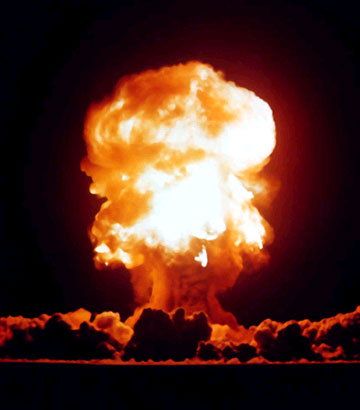With the advent of the Cold War, states’ possession of nuclear weapons and the capacity of these weapons to inflict catastrophic damage on enemies became a primary concern for the maintenance of inter- national peace and security. In an effort to reduce the danger that nuclear technology held, the Treaty on Non-proliferation of Nuclear Weapons (NPT) was proposed, with the Russian Federation, the United Kingdom, and the United States acting as depositaries. The treaty entered into force on March 5th 1970, after being ratified by 187 states. The NPT holds great significance and authority as the most ratified arms limitation/disarmament agreement in existence. In fact, it is the only fully binding commitment to disarmament that exists within a multilateral treaty. In accordance with the events leading to the proposal of the treaty, the main objective of the NPT is to prevent the spread of nuclear weapons and the technology to develop these weapons. The goal of this objective is to eventually achieve worldwide nuclear disarmament, greatly increasing global stability and reducing threats to international security.
It was discovered that Iran has been constructing an enrichment facility at Qom and has enriched uranium to 20% without informing the IAEA.
The NPT is also committed to the promotion of peaceful usage of nuclear technology and ensuring that all states have equal access to it. A significant aspect of the NPT is the implementation of safeguards to ensure compliance with international regulations. These safeguards generally consist of inspections of a state‘s nuclear program, which are con- ducted by the International Atomic Energy Agency (IAEA).
The IAEA works in agreement with the United Nations as the central international organization for nuclear peace and co-operation. Established in 1957, the IAEA facilitates inspections and investigations of state nuclear programs, as outlined under the NPT safeguard system. Although the IAEA is an independent body from the UN, it does report activities and findings on an annual basis to the General Assembly. When a state is non-compliant with NPT safeguards or is believed to pose a potential threat to international security, the IAEA reports directly to the Security Council.
On February 4th 2006, the IAEA adopted a resolution concerning further implementation of safeguards in Iran. It was noted that after three years of investigation, the IAEA could not conclude that Iran‘s nuclear program was intended for peaceful purposes as the state insists. This lack of confidence in Iran‘s nuclear program was increased due to Iran‘s past refusals to co-operate with the IAEA through non-compliance with NPT safeguards and a history of concealing nuclear activity. It was also discovered that Iran possessed a document pertaining to the production of uranium metal hemispheres, which is directly related to the production of nuclear weapons. The IAEA called for Iran to suspend all nuclear activity until verification could be completed and requested compliance with Additional Protocol measures, which extend beyond the scope of traditional safeguards. It was expressed in the resolution that rebuilding confidence in Iran‘s nuclear pro- gram would greatly increase the stability of the situation in the Middle East. This sentiment was shared by the United Nations and various other international organizations.
Only four recognized sovereign states are not currently parties to the treaty: India, Israel, Pakistan and North Korea.
However, Iran has thus far been unwilling to co-operate with the IAEA to make their nuclear program more transparent, constituting a threat to the maintenance of international peace and security. It was discovered that Iran has been constructing an enrichment facility at Qom (in breach of the IAEA safeguards imposed in 2006) and has enriched uranium to 20% without informing the IAEA. The refusal of Iran to co-operate with international organizations thus far has demanded the immediate attention of the Security Council.
Descriptions
International Atomic Energy Agency (IAEA)
In 1957, the United Nations created the International Atomic Energy Agency for the express purpose of accelerating and enlarging the contribution of atomic energy to peace, health, and prosperity throughout the world. The Vienna agency, which has about 2,200 professional and support staff members from more than 90 nations, wears two hats — both promoting and regulating the global development of civilian nuclear industries, including nuclear power. Accordingly, the IAEA is obliged under its statute to ensure that all the activities in which it takes part are directed exclusively to civilian uses. A second important task of the IAEA, then, is to establish a system of supervision and control to make certain that none of the assistance programs that it fosters and none of the materials whose distribution it supervises are used for military purposes.
The enormous efforts required by such a mandate were rewarded in 2005 as the IAEA and its Director General Mohamed El Baradei were jointly awarded the Nobel Peace Prize for “their efforts to prevent nuclear energy from being used for military purposes and to ensure that nuclear energy for peaceful purposes is used in the safest possible way.” But despite such accolades, Mr. El Baradei and the IAEA have come under intense criticism for its handling of Iran’s nuclear program. For instance, the Israeli newspaper Haaertz has accused Mr. El Baradei of repeatedly distorting his inspectors’ reports on Iran’s nuclear sites, and for making sure that the IAEA’s periodic reports about Iran would be camouflaged in diplomatic gibberish. The article goes on to say that, “time and again they repeated the phrase that “no proof was found” that Iran’s nuclear program had military aspects, even though they were blatantly obvious”.
…nuclear energy now produces about 15% of the globe’s electricity and emits far fewer greenhouse gases than other power sources.
The Nuclear Non-Proliferation Treaty (NPT)
The Nuclear Non-Proliferation Treaty, formally called the Treaty on the Non- proliferation of Nuclear Weapons, is the cornerstone of the international effort to halt the proliferation, or spread, of nuclear weapons. It was signed in 1968 by three nuclear powers – the United States, the Soviet Union, and the United Kingdom – and forty other countries, but has since grown to include 189 parties. Only four recognized sovereign states are not currently parties to the treaty: India, Israel, Pakistan and North Korea. India, Pakistan and North Korea have openly tested and declared that they possess nuclear weapons, whereas Israel has had a policy of opacity regarding its own nuclear weapons program.
Although the concepts of “pillars’ appears nowhere in the NPT, the treaty is nevertheless sometimes interpreted as a 3 pillar system, with an implicit balance among them: non- proliferation, disarmament, and the right to peacefully use nuclear technology. Article II forbids non-nuclear-weapon states that are parties to the treaty to manufacture or otherwise acquire nuclear weapons or nuclear explosive devices. Article III concerns controls and inspections that are intended to prevent the diversion of nuclear energy from peaceful uses to nuclear weapons or explosive devices. These safeguards are applied only to non-nuclear-weapon states and only to peaceful nuclear activities. The treaty contains no provisions for verification of the efforts by nuclear-weapon states to prevent the proliferation of nuclear weapons.
Under the provisions of Article IV, all parties to the treaty, including non-nuclear-weapon states, may conduct nuclear research and development for peaceful purposes. In return for agreeing not to develop nuclear weapons, non-nuclear-weapon states receive two promises from nuclear-weapon states: the latter will help them to develop nuclear technology for peaceful purposes, and the latter will “pursue negotiations in good faith on effective measures relating to cessation of the nuclear arms race at an early date and to nuclear disarmament”.
…“from 1955 to 2000, no country began a nuclear weapons program without first receiving civilian assistance”…
Although various components of the treaty have been subject to criticism, it is the provisions in Article IV that reveal a certain tension within the NPT’s stated objectives. For instance, the promotion of peaceful nuclear energy should be viewed as a double- edged sword. On the one hand, nuclear energy now produces about 15% of the globe’s electricity and emits far fewer greenhouse gases than other power sources. On the other hand, agreements on nuclear cooperation have often been a precursor to the development of nuclear weapons programs because such deals provide ready access to technologies useful for developing weapons.
As the University of South Carolina political scientist Matthew Fuhrmann argued in the summer 2009 issue of International Security, the initiation of peaceful nuclear cooperation is so strongly correlated with the development of weapons programs that “from 1955 to 2000, no country began a nuclear weapons program without first receiving civilian assistance” (although he also points out that a vast majority of states with nuclear energy have not developed weapons programs).
Key Iranian Nuclear Sites
Natanz – Uranium enrichment plant
- Iran resumed uranium enrichment work at Natanz in July 2004, after a halt during negotiations with leading European powers over its programme.
- It announced in September 2007 that it had installed 3,000 centrifuges, the machines that do the enrichment.
- This is the facility at the heart of Iran’s dispute with the United Nations Security Council.
- The Council is concerned because the technology used for producing fuel for nuclear power can be used to enrich the uranium to a much higher level to produce a nuclear explosion.
Qom – Uranium enrichment plant
- The facility is believed to be on a mountain on a former Iranian Revolutionary Guards missile site to the northeast of Qom on the Qom-Aliabad highway, Western diplomatic sources say.
- Construction on the secret facility started in earnest in mid-2006.
- It is believed that the plant is not yet operational but that it has the facility for 3,000 centrifuges for the enrichment of uranium.
- Iran wrote to the International Atomic Energy Agency saying it intended to build a plant to enrich uranium to 5% – not enough for a weapon.





